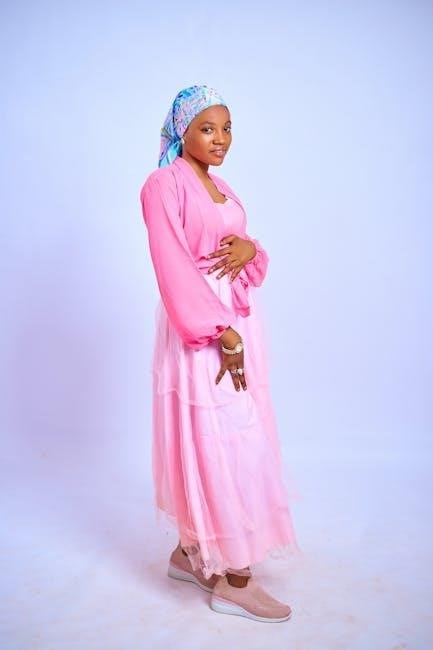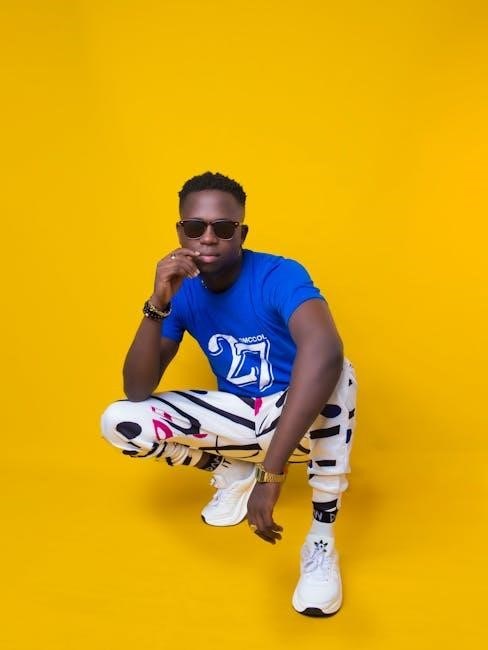Men’s bracelet length varies based on wrist size, typically ranging from 18․3cm to 22․3cm․ Measure the thickest part of your wrist for accuracy․ Use a size chart to determine the best fit, ensuring comfort and style․ Always consider material and type when selecting your bracelet size for a perfect look․
Choosing the right bracelet size is essential for both comfort and style․ Men’s bracelets come in various lengths, and proper sizing ensures a secure yet comfortable fit․ The key to finding the perfect bracelet is understanding your wrist size and how it relates to bracelet length․ A well-fitted bracelet should neither be too tight nor too loose, striking the right balance for everyday wear or special occasions․
Bracelet sizing is influenced by factors such as wrist circumference, bracelet type, and material․ For example, leather bracelets may require a slightly different approach than metal or chain styles․ Measuring your wrist accurately is the first step in determining your ideal bracelet size․ Use a flexible measuring tool, such as a string or ruler, to wrap around the thickest part of your wrist, usually just above the wrist bone․
Understanding how bracelet length corresponds to wrist size is crucial․ A bracelet that is too small may cause discomfort, while one that is too large may slip off easily․ Referencing a size chart or guide can help you make an informed decision․ Whether you’re shopping for a delicate chain or a bold cuff, proper sizing ensures your bracelet looks and feels its best․
How to Measure Wrist Size
Measuring your wrist size accurately is the foundation of finding the perfect bracelet fit․ To do this, wrap a flexible measuring tool, such as a string or a ruler, around the thickest part of your wrist, typically just above the wrist bone․ Ensure the palm of your hand is facing up and your hand is relaxed, not clenched into a fist․
For the most precise measurement, press the string or ruler gently against the skin without tightening it too much․ If using a string, mark the point where it overlaps and then measure the length using a ruler․ This will give you your wrist circumference․ Note that measurements can vary slightly depending on the time of day, so it’s best to measure in the morning or early afternoon for consistency․
Keep in mind that different bracelet types may have specific fitting preferences․ For example, cuff bracelets may require a slightly looser fit, while chain bracelets might fit more snugly․ Always refer to the specific sizing guidelines for the style you’re interested in to ensure the best fit․ If measuring alone, consider using a mirror to get an accurate reading․
Men’s Bracelet Size Chart

| Size | Wrist Size (cm) | Wrist Size (in) |
|---|---|---|
| Small | 16․5 ⎼ 17․5 | 6․5 ౼ 6․9 |
| Medium | 17․5 ⎼ 18․5 | 6․9 ⎼ 7․3 |
| Large | 18․5 ౼ 19․5 | 7․3 ౼ 7․7 |
| X-Large | 19․5 ౼ 20․5 | 7․7 ⎼ 8․1 |
This chart provides a general guide for men’s bracelet sizes based on wrist circumference․ Use the measurements to select a bracelet that fits comfortably․ If your wrist size falls between two sizes, consider choosing the larger size for a better fit․ This ensures the bracelet is neither too tight nor too loose, allowing for optimal comfort and style․
Understanding Wrist Size and Bracelet Length
Wrist size and bracelet length are closely linked to ensure a proper fit․ Measure your wrist at the widest point, typically just below the base of the hand, using a flexible tape measure or a piece of string․ This measurement will fall into specific categories: Small (up to 17․5 cm), Medium (17․5–18․5 cm), Large (18․5–19․5 cm), and X-Large (19․5 cm and above)․ Bracelet length should correspond to these categories, ensuring the bracelet is neither too tight nor too loose․ For example, a Small wrist size corresponds to a bracelet length of 18․3–19․3 cm, while an X-Large requires 21․3–22․3 cm․ Proper fit ensures comfort and prevents the bracelet from slipping off or feeling restrictive․ Always consider the type of bracelet, as some styles may require slightly different measurements for optimal wearability․
Types of Men’s Bracelets and Their Sizing
Men’s bracelets come in various styles, each with unique sizing considerations․ Leather bracelets, for instance, often have fixed sizes, ranging from small to extra-large, and are designed to fit snugly without adjusting․ Chain link bracelets, such as curb or Figaro styles, may have adjustable clasps, allowing for a customizable fit․ Cuff bracelets, which are rigid and open-ended, are sized based on the width of the opening, typically ranging from 6․5 to 8 inches․ Beaded or rope bracelets are often stretchy or adjustable, making them versatile for different wrist sizes․ Magnetic or toggle clasps are common in these designs, ensuring a secure and comfortable fit․ Adjustable bracelets, such as those with sliding knots or cord ties, are one-size-fits-most and ideal for varying wrist sizes․ Understanding the specific type of bracelet helps in selecting the right size, ensuring both style and comfort․ Always refer to the size chart for the exact measurements, as sizing can vary slightly between materials and designs․
How to Use a Bracelet Size Chart
Using a bracelet size chart is straightforward and ensures a perfect fit․ Start by measuring your wrist accurately using a flexible tape measure or a piece of string wrapped around the thickest part of your wrist․ Record the circumference in centimeters or inches․ Next, compare your measurement to the size chart provided by the manufacturer or retailer․ Match your wrist size to the corresponding bracelet size, taking note of the recommended length for your wrist size․ Pay attention to whether the chart is based on wrist size or bracelet length, as this can vary․ If your measurement falls between two sizes, opt for the larger size for comfort․ Some charts may also provide specific guidance for different bracelet types, such as leather or chain link designs․ Always refer to the chart specific to the bracelet you’re purchasing, as sizing can vary slightly between brands and materials․ By following these steps, you can confidently select the right size for a comfortable and stylish fit․
Material-Specific Sizing Tips

Different materials require unique sizing considerations when selecting a men’s bracelet․ For leather bracelets, choose a size that allows a snug fit without being too tight, as leather can stretch slightly over time․ Chain link bracelets, such as stainless steel or silver, should fit comfortably but not slide excessively on the wrist․ Adjustable bracelets offer flexibility, allowing you to customize the fit, while cuffs with openings may need to be gently bent to accommodate your wrist size․ Beads or woven bracelets might require a slightly looser fit for ease of movement․ Always consider the material’s durability and how it may affect the bracelet’s longevity․ By tailoring your choice to the specific material, you ensure both comfort and style․ Proper sizing enhances the overall aesthetic and functionality of the bracelet, making it a timeless accessory for any occasion․
Adjusting Bracelet Length

Adjusting bracelet length ensures a perfect fit and enhances comfort․ For cuff-style bracelets, gently bend the opening to fit your wrist without forcing it, as excessive bending may damage the material․ Leather bracelets can stretch slightly over time, so start with a snug fit․ Chain link bracelets often feature adjustable clasps, allowing precise sizing․ Beaded or woven bracelets may require rethreading or resizing by a professional․ Always measure your wrist accurately before adjusting to avoid over-tightening or loosening․ Use a string or ruler to determine the ideal length, ensuring the bracelet sits comfortably without restricting movement․ For adjustable designs, test the fit by sliding the bracelet on and off your wrist effortlessly․ Proper adjustment ensures the bracelet stays secure while maintaining a stylish appearance․ By tailoring the length to your wrist, you achieve a personalized fit that complements your accessory collection․ Regularly check adjustable bracelets to ensure they remain secure and comfortable over time․

Common Mistakes in Choosing Bracelet Size
One of the most common mistakes when selecting a bracelet size is measuring the wrong part of the wrist․ Many individuals measure too loosely or too tightly, leading to an uncomfortable fit․ Another error is not considering the type of bracelet, as cuff, chain, or leather styles have different sizing requirements․ Some people overlook the importance of using a size chart, guessing their size instead of measuring accurately․ Additionally, failing to account for material thickness, such as leather versus metal, can result in a poor fit․ Ignoring the recommended sizing ranges for your wrist circumference is another frequent mistake․ To avoid these errors, always measure the thickest part of your wrist and refer to the specific size chart for the bracelet style you’re choosing․ If unsure, opt for the larger size to ensure comfort and ease of wear․ Accurate measurement and careful selection are key to finding the perfect fit for your bracelet․
Final Tips for the Perfect Fit
Achieving the perfect fit for a men’s bracelet involves a combination of accurate measurement, understanding the style, and personal preference․ Always measure the thickest part of your wrist for the best results․ Use a flexible measuring tool, such as a string or ribbon, and wrap it snugly but not too tightly around your wrist․ Consider the type of bracelet—leather, chain, or cuff—as each has specific sizing guidelines․ Refer to a reliable size chart to match your wrist measurement with the appropriate bracelet length․ If you fall between sizes, opt for the larger option to ensure comfort․ Additionally, think about how you want the bracelet to sit on your wrist․ Some prefer a tighter fit for a more secure feel, while others like a looser, more casual look․ Lastly, if the bracelet is adjustable, this can provide flexibility in achieving your desired fit․ By following these steps, you can confidently select a bracelet that complements your style and ensures a comfortable, tailored fit․
